With the global pursuit of sustainable transportation, electric vehicles (EVs) are rapidly emerging. In this context, charging infrastructure has become a key component to support the development of EVs.
As the world’s largest EV market, China’s charging station development is particularly rapid. The purpose of this paper is to provide an in-depth discussion of the internal structure and working principles of two types of charging stations widely used in the market – AC charging stations and DC charging stations – and their roles in the EV charging ecosystem.
Charging stations, often referred to as EV power supply stations, are key devices for EV charging.
Depending on the charging method, charging post are categorized into alternating current (AC) and direct current (DC) charging station.
AC charging station are typically used in homes and commercial locations, while DC charging stations are commonly found at public charging stations, offering faster charging speeds.
Whether they are AC or DC charging posts, they include several key components: a power input connector, a controller, a charging connector, and a user interface.

Features and Differences Between DC and AC Charging Stations
The controller is the brain of the charging port, managing the transmission of power, control of the charging process, and communication with the vehicle.
The design of the AC charging station is relatively simple. It mainly consists of a power input module, control module, user interface, and charging interface.
The power input module receives AC power from the grid, while the control module monitors the charging process and ensures safety.
When an electric vehicle is connected to an AC charging post, the vehicle’s internal charger converts AC power to DC power to charge the battery. This conversion process limits the speed of charging because of the limited size and efficiency of the on-board charger.
Applicable Environment
AC charging posts are typically used in residential and commercial areas due to their lower cost and ease of installation. They are suitable for charging at night or when vehicles are parked for longer periods.
DC charging posts are more complex than AC charging posts. They have built-in high-power rectifiers and filters that convert AC power directly into DC power, and then precisely regulate the output current and voltage through a control system.
DC chargers supply DC power directly to the electric vehicle’s battery pack, bypassing the vehicle’s internal charger. This allows for higher charging power and faster charging speeds.
DC charging posts are usually installed at public charging stations and are ideal for scenarios where fast charging is required, such as highway service areas or urban fast charging stations.

Charging Speed
In terms of charging speed, DC charging stations offer faster charging speeds due to their high power output capability, allowing EVs to be fully charged in a shorter period.
In contrast, AC charging stations offer slower charging speeds and are more suitable for long periods of parking.
DC charging stations typically cost more to install and maintain than AC charging stations due to their higher technical complexity.
However, as the technology develops and is produced on a larger scale, the cost is gradually decreasing. AC charging stations have a higher penetration rate due to their simplicity and cost-effectiveness.
DC charging stations, on the other hand, are important in public charging networks due to their fast charging capability. DC charging stations are relatively complex to maintain and require more frequent inspections and maintenance. AC charging stations, on the other hand, have lower maintenance costs due to their simple structure.
The charging station market has experienced rapid growth in recent years, and China’s government has formulated a series of standards and policies to guide the development of charging stations, such as the GB/T series of national standards, which aim to promote technological innovation and ensure charging safety.
China’s charging station market brings together several manufacturers, such as TKT, TGOOD, and Star Charge, which continue to introduce more efficient and smarter charging solutions.
The energy efficiency of charging stations directly affects the overall environmental performance of electric vehicles. As technology advances, improvements in charging efficiency will further reduce the environmental footprint of EVs.
Future charging technologies, such as wireless charging and smart charging systems, are expected to further enhance user experience and charging efficiency.
The charging post market is expected to continue to grow in the future, but it also faces challenges such as uneven charging network coverage and harmonization of technical standards.
Summary
To summarize, the rapid development of charging stations as a core component of the EV ecosystem worldwide is of great significance in promoting the popularity of EVs and environmental protection.
With technological advancements and policy support, it is expected that charging stations will continue to make progress in improving efficiency, lowering costs, and enhancing user experience, paving the way for the future of electric vehicles.
TKT is an experienced EV charging station manufacturer. Our factories have been at the forefront of producing high-quality charging stations to meet the growing demand. Our manufacturing plant utilizes state-of-the-art technology, equipped with advanced machinery and skilled employees to ensure the production of efficient and reliable charging stations. In addition, our factories adhere to strict quality control measures to ensure that each charging post is rigorously tested to meet the highest safety standards.
From residential to commercial applications, our wide range of charging stations offers versatility and convenience to all-electric vehicle owners. With the factory’s relentless pursuit of innovation and customer satisfaction, we are confident that we can provide the industry with best-in-class charging solutions that will drive the future of electric vehicles.

